The sky is a steel grey and the bitter wind carries an icy edge when I meet farrier Monica Hoff in a Catholic church parking lot in the crossroads community of Mackville, a few miles north of Appleton in Wisconsin’s Fox River Valley.
“The only things in Mackville are the church and a strip joint,” Hoff had told me on the phone a few days earlier. “If you’re going to meet in Mackville, the church is the way to go.”
Hoff has scheduled a day of visiting backyard horses. There are more than a few of them in this part of “America’s Dairyland,” where it’s not unusual for dairy farmers to keep horses for family members to ride. The area also has large numbers of hobby farms, where professionals who work for the paper-making companies and other firms that drive the local economy have chosen to live.
8:45 a.m. Hoff lives in Green Bay, where the Fox River flows into the Lake Michigan bay that gave the city its name. She’s driven some 60 miles to the Appleton area, where she has a number of long-time clients. We’re running a bit late, so once I arrive, she gets her Dodge Dakota on the road and heads for the home of her first customer.
Riding along with Hoff is her constant companion, Rowdy, an obviously devoted Australian shepherd. Dog owners will tell you a dog’s behavior is a reflection on its master. Rowdy may be the best-behaved dog I’ve ever seen. He sits quietly in his harness inside the cab throughout the day, alertly watching what’s going on outside. I don’t hear him bark once, even when dogs at various stops are raising a ruckus.
9:05 a.m. Hoff pulls into a long driveway at a neat, brown-sided home with a small stable in the backyard. She gets her apron and shoeing box out of the back of her rig, then knocks on the backdoor of the house, looking for her client.
The horse owner, Cindy, pops around from the front of the house, with three small, bundled-up children in tow. She tells Hoff she’s found herself unexpectedly baby-sitting that day, but adds that she’s set a VCR up in the stable with an animated movie to keep the children’s attention. Hoff heads for the stable as Cindy shepherds the children along behind her.
9:10 a.m. Inside the stable waits a trio of Arabian mares, their reddish coats grown shaggy in the face of the coming winter. Quarters are tight inside the stable, so Cindy and Hoff crowd into one of the stalls, which holds two of the mares. Cindy leads one of the two through the gate into the second stall, where the third mare is stabled. She then returns and tends the first horse’s head as Hoff goes to work on the horse remaining in the stall.
“I make sure someone is going to be home,” Hoff tells me later. “One of my rules is that I want someone to be there when I’m working on the horse. I don’t take a chance on being alone. Rowdy can’t dial 911.”
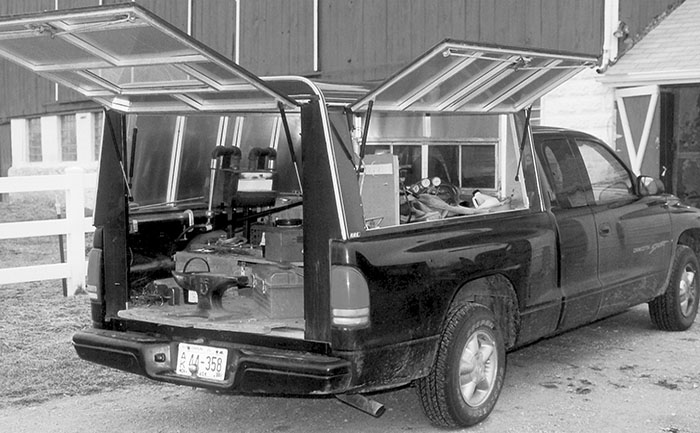
SHOEING RIG AND SHELTER. Monica Hoff does her shoeing out of a Dodge Dakota pickup truck. The swing-out side and back doors make it easy to get to everything within the rig. The back door also provides overhead shelter in inclement weather.
9:20 a.m. Hoff finishes trimming the first mare and Cindy leads in the second. It’s a transition kind of day in hoof care. With the onset of winter, Hoff is switching from a 6-week to an 8-week interval between visits. The shoes have been pulled from these horses already.
“These horses will be ridden a lot less for the next few months,” she says. “It’s getting too cold to spend much time out riding.”
The video isn’t having much luck holding the children’s attention. They’re more interested in trying to figure out what Hoff is doing with the horses. Cindy explains that one of the mares is the mother of the other two. Cindy and Hoff talk about the health of various canines who are also members of Cindy’s menagerie as the farrier quickly moves ahead with her work. The three Arabians are well-behaved and Hoff is able to keep working as she listens to Cindy.
9:30 a.m. “Are these guys all doing OK?” Hoff asks as she finishes up the trim on the second mare. Cindy tells her one of the mares had been suffering from a hoof abscess recently.
“Did you call the vet or did it heal itself?” Hoff quickly asks.
“I had to call the vet,” Cindy answers. “She literally would not walk on it. I was afraid she might have broken something.”
Hoff takes a close look at the hoof in question and seems satisfied that it is healing well. She finishes up the trim, packs up her shoeing box and heads back to the truck.
“One of the nice things about Cindy’s horses is they are used to a lot,” Hoff says. “They’re used to the children, they have dogs, her husband drives a semi and they back that right in here. They’re very acclimated.”
As we leave the stable, the kids lag behind, their attention captured—finally—by the video. Cindy ducks into the house for her checkbook and when she returns, writes a check for $66 for the three trims. Before she leaves, Hoff sets the next appointment, handing the owner an appointment slip.
“Remember, we’re changing to 8 weeks now,” she reminds Cindy just before she heads back out on the road.
10:03 a.m. “I have all my clients on a schedule,” she explains. “I’ll put it in my book before I leave, then they know when I’m coming and I don’t get overloaded.”
It takes about 15 minutes to drive to Hoff’s second appointment of the day. That’s fine with her.
“Days like this are kind of nice,” she says. “You’ve got a little break and it gives you a chance to rest.”
Hoff says there are days when she joins her mentor, Paul Schmidt, and his son in a full day’s shoeing at some of the larger stables in the area. She enjoys the work, but admits the days can be long.
“When you’re shoeing all day like that, your back can really get sore,” she says. “I actually have some days when I have several horses at the same stable and I’ll stop and shoe some of the horses, then take a break and go to another client, then come back to the stable. It might not make the most sense from a logistics standpoint, but it gives my back a break.”
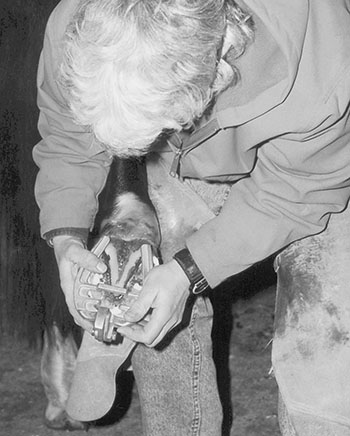
LAST CHECK. Farrier Monica Hoff uses a hoof gauge to check the trim she’s done on a hoof.
10:18 a.m. Hoff’s second stop is at a large, old-style farmhouse, with well-kept grounds and a brightly painted red barn and outbuildings. Shortly after she pulls in, she’s joined by Kelly, a laboratory technician at a local hospital. After a quick greeting, we enter the barn, where four horses are stabled in large, airy stalls. Kelly quickly leads a tall paint out onto a rubber floor mat and ties it in cross-ties.
Hoff and Kelly talk about the local deer hunt, which is as much a part of a Wisconsin Thanksgiving as turkey and cranberries. Kelly mentions that she had let the horses out to run in the pasture the day before, after the season had ended. She had restricted the horses to the paddock outside the barn while the hunting season was open “just in case.”
10:28 a.m. “Baby,” a year-old gelding, is next. While not exactly misbehaving, Baby is fidgety, trying to look back and see what Hoff is up to and occasionally trying to pull his hoof away from the farrier.
Hoff keeps talking to him in a low, crooning voice and pauses a couple of times to have Kelly move him back to the center of the mat.
“Baby horses are always fun,” she remarks with a wry chuckle.
No matter how fussy Baby gets, Hoff sticks with the task at hand. Despite Baby’s desire to have things otherwise, all four of his hooves are quickly trimmed. Hoff cleans the frog, trims and rasps each hoof and makes a final check with a hoof gauge on each foot.
10:43 a.m. Next, Kelly leads out a big grey that she’s boarding for its owner. The two seem a bit leery of the big horse, because its owner had recently had a baby, making it difficult for her to spend much time working with the animal.
But the grey proves to be cooperative and Hoff is able to work quickly.
“I’m not asking her to do much,” she says. “I’ve been keeping her hinds real low. I figure until she gets a little more flexible about that with her owner, she isn’t going to like it if once every 6 or 8 weeks this person comes and makes her stretch her leg back.”
11:00 a.m. Hoff finishes the trim quickly, then moves on to “Old Man Copper,” as Kelly affectionately calls the horse she’s owned the longest.
When Hoff finishes, Kelly hands her a check for the trims on her three horses, and cash she collected from her boarder.
“I let her know in advance when Monica is going to be coming,” Kelly explains. “That way the money is here when Monica is.”
11:20 a.m. Hoff sets up another appointment for 8 weeks down the road, adding another reminder. Her next appointment isn’t until about noon, so she schedules a short break at a convenience store/gas station. She buys a soda, checks out the lunch specials being offered and suggests we stop back there to eat after the next appointment. As she sips her soda, she talks a bit about a topic she’s obviously big on: personal safety.
Hoff wears safety goggles while working on horses—even when she’s only trimming, as she is today.
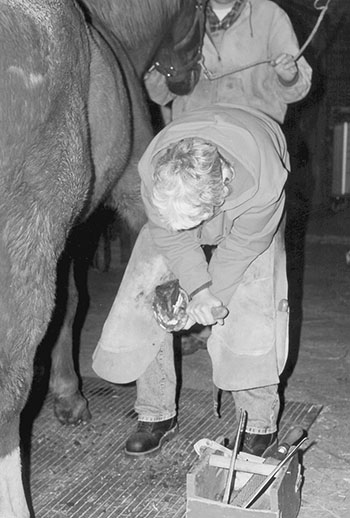
HELP ON HAND. Monica Hoff uses a hoof knife while the horse owner minds the horse in the background. As a safety precaution, Hoff schedules backyard horses when owners will be on hand when she does her shoeing.
“Even if you’re not putting on shoes, there’s dirt, bits of hoof, even a chip of a hoof knife that could fly up into your eye,” she says. “It only takes a split second.”
She also says she wears ear protection when she’s doing forging work.
11:40 a.m. Hoff, 45, came to farriery work at a later age than some. Her educational and professional background is also different than that of many farriers. She holds a bachelor’s degree in sociology and criminology from the University of Wisconsin-River Falls, as well as a master’s degree in student personnel from Kent State University in Ohio. She also spent 7 years on active duty as an officer in the United States Navy and was recently promoted to the rank of commander in the Naval Reserve, where she’s a “hard-hat” diver. In addition, she serves as the humane officer in the Brown County township where she lives and is active in several canine training organizations.
All those activities are part of the reason she likes the flexibility working as a farrier gives her. In fact, that flexibility is vital.
“I have to spend one weekend a month with my reserve unit (at Great Lakes Naval Training Station, north of Chicago),” she says. “Plus I spend 2 weeks each year on active duty. Having my customers on a 6- or 8-week schedule lets me work them in around my reserve times.”
Hoff shoes 5 days most weeks. That’s less than she shod when she started, more than she’d like to shoe in the not-too-distant future.
“When I started, I wasn’t sure if I was going to be able to make a living doing this, so I’d shoe 3 days a week and maybe Saturday morning and worked a full-time night-shift job,” she recalls.
She gave up the night-shift job when her shoeing practice widened. Now she’s looking forward to the day when she might cut back her shoeing to 4 or even 3 days a week.
“It’s hard though,” she admits. “I’ve got a lot of great customers and I don’t want to let them down.”
11:50 a.m. Hoff decides to head for her next customer’s home a little early. She says she doesn’t worry too much about being early for customers on a day like this. If she has to wait for a short time, she can catch up on her paper work. She also carries a cell phone that allows her to call customers who are due for shoeing at later dates. She doesn’t leave the phone on for incoming calls, however, because she doesn’t want to be distracted from the work at hand.
11:55 a.m. We’re a little early for the noon appointment, but Karen, the customer, a co-worker of Kelly, the owner at the previous stop, pops out of the small farm house quickly and accompanies us to the barn where a pair of horses are waiting.
As Hoff works on the first horse, Karen shares a couple of stories about her farrier–stories she prefaces by saying, “Monica is just the best, but she’s so humble she would never admit it.”
“Smokey, this guy,” Karen says, patting the big grey that Hoff is working on, “once got so relaxed while she was working that he practically fell asleep. Then he woke up with a start and sent Monica flying on her butt.”
“That flight response kicked in,” says Hoff with a wry laugh. “That’s horses though. When something scares or startles them, they jump 3 feet, run 20 yards and then stop and look and see if there was something worth being scared of.”
12:05 p.m. Smokey is acting up, but Karen and Hoff, working together, don’t have too much trouble keeping him under control. Karen asks about the progress of a small hoof crack that Hoff has been keeping an eye on.
Hoff examines the foot and tells her the crack seems to be growing out but warns it may still take some time to grow out the rest of the way as hoof growth tends to slow in the cold winter weather.
12:10 p.m. Hoff moves on to Karen’s second horse. She had worked on Smokey in his stall, but after looking over the situation, decides the second stall is too dark to work safely in. She asks Karen to lead the second animal out to the barn floor area. Hoff works quickly and soon has the trim completed.
12:20 p.m. While Hoff is scheduling the horses for their next visit, Karen asks about a couple of training problems she’s having with her dogs. Hoff listens to Karen describe the problem, then offers a few words of advice at no extra charge—a “value-added” to her shoeing visit.
12:25 p.m. Karen confirms that she hasn’t been riding much with the onset of colder weather. Hoff again notes that these particular horses aren’t shod at this time. She says it’s something she likes to avoid, particularly with the icy conditions that often come with Wisconsin winters.

RASPING FLAT. Monica Hoff doesn’t use a “pure” four-point trim, although she does apply many of its principles in her shoeing work.
“Horses can’t ice skate,” she says. “If I do have to put shoes on a horse this time of year, I make sure to use studs or Borium.”
12:40 p.m. We break for lunch at the same convenience store we had visited earlier. Over chicken and a muffin, Hoff shares more of her background. She received her formal farrier training at Montana State University in Bozeman, Mont., where she studied under Tom Wolfe. She said the experience at Montana State was a good one, as the school is very “horse oriented.”
12:50 p.m. “They have their own rodeo team,” she points out as an example. “We got to work on pretty good, steady horses.”
After she finished her formal training, she worked with Paul Schmidt, who shoes out of Reedsville, Wis. He’s the farrier she mentioned still teaming up with. She credits the farrier with teaching her more about horseshoeing as well as helping her get started on her own.
“I got some of his overflow and he’d let me know about new customers or refer them to me,” she says.
Hoff is a big believer in continuing farrier education—not a big surprise, given her own broad educational background.
“It’s important to do something to keep learning,” she says, “attend clinics, belong to a shoeing organization or at least read. It’s all part of being a professional. Otherwise, you get left behind.”
1:03 p.m. Like most farriers, Hoff adjusts her shoeing and trimming to the needs of the individual horse. She says the trims she’s been doing today are each a little different.
“I generally trim a short toe and a good flat base,” she explains. “It’s not a pure four-point trim although I apply the principles of it.”
Hoff gets most of her farrier supplies through Centaur Forge in Burlington, Wis. She uses a lot of St. Croix shoes, though not exclusively. She says if she were to offer advice to someone just starting out on a shoeing career, it would be not to skimp on buying the tools of the trade.
“I’m a big believer in paying a little more to get a lot more quality,” she says. “If you buy good tools, they’ll pay off in the long run.”
Hoff says she’s fortunate in not having to deal with a lot of problem hooves in her practice.
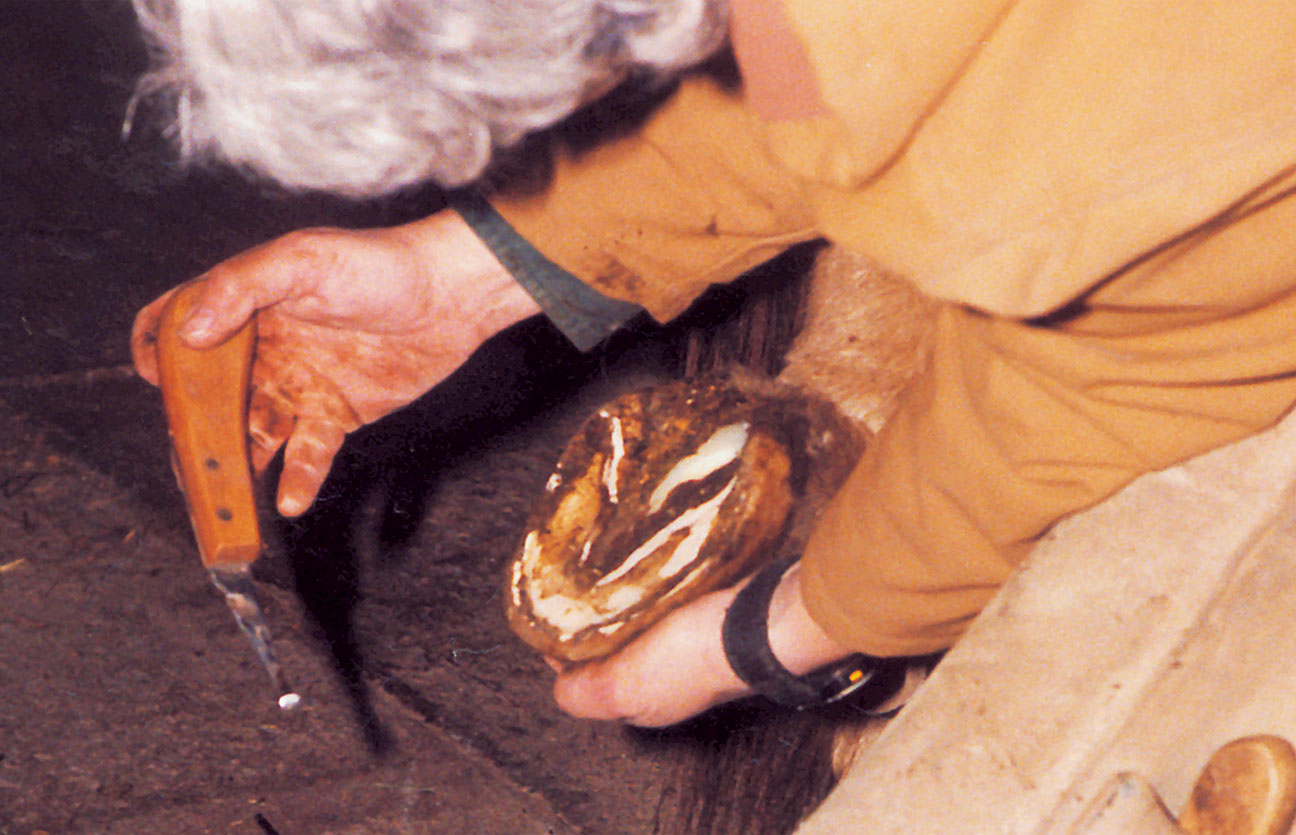
BAREFOOT FOR WINTER. Most of the horses Monica Hoff is seeing on this day go barefoot during the Wisconsin winter, when they aren’t ridden as much and icy conditions are common.
“Most of the horses I shoe have pretty good feet,” she says. “They’re taken care of and they’re not ridden real hard.”
Hoff says many of the horses she’s trimming today go barefoot year-round. These backyard horses have been well-stabled, fed and are obviously very important to their owners.
“I’m not going to start changing a horse’s feet when he’s sound,” she says. “I can’t be experimenting on someone’s pet.”
Hoff finds that well-cared-for horses are easier to work with—and that’s important to her.
“I’m to a point where I don’t feel that I have to take every horse someone calls me about,” she says. “Young farriers or those just starting out sometimes feel like they have to. You’re just asking to get hurt.”
1:45 p.m. After lunch, Monica drives to her one non-backyard stop of the day. She pulls in outside a large, well-kept boarding stable in a small, crossroads community. Hoff admits that at this stop, she’s breaking a couple of her own rules.
“I’m going to lead the horse out and secure her myself,” she says. “I’d also be working on the horse by myself if you weren’t here.”
She points out that even when she bends her own rules, she does so within limits. The horse she’s going to be working on is in its stall when she arrives, and the big stable has a well-lit area where she can tie the horse and work. She says she wouldn’t go out into a paddock or pasture and catch the horse.
She also knows the horse in question is well-mannered and that the stable owners are inside the house and would come check on her if she did not reappear at her truck in a short time.
1:55 p.m. Hoff leads the horse to the shoeing area, fastens it with cross-ties and goes quickly to work. She trims each foot, rasps the hoof wall smooth, then checks it with a hoof gauge, giving it a final few passes with the file if needed. The horse is a small Arabian and stands almost statue-like as Hoff works. When she’s finished, she looks over a bulletin board hanging near the doorway to the barn. She points to a notice left by another area farrier.
“This is another way of scheduling,” she says. “He’s letting everyone know he’ll be here on a particular day and giving horse owners a chance to sign up now.”
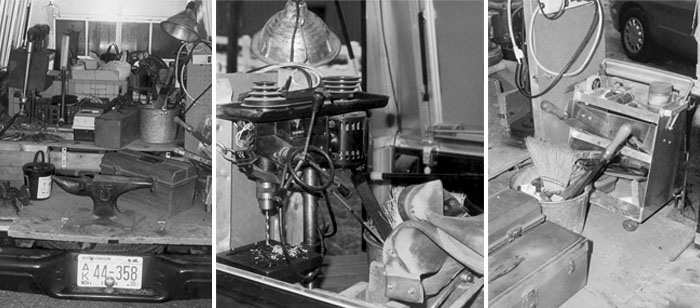
SURPRISINGLY ROOMY. Although the Dodge Dakota shoeing rig used by Monica Hoff is relatively small, it it surprisingly roomy. Drawers beneath the raised deck behind the anvil (left) hold a variety of horseshoes and there’s enough room for a drill press and forge (middle) as well as a shoeing box and other toolboxes (right).
Hoff says it can be an effective method, but one that probably wouldn’t work well for her.
“He has apprentices and other people working for him, so he has a little more flexibility,” she says. “I’m alone and if I came here and more people had signed up then I was planning on, I might not be able to get everyone done in a day, or it might make me late for other appointments I had later in the day.”
2:02 p.m. As Hoff leaves the barn, the stable owner steps out the back door of the house and waves, an indication that she was keeping tabs on the farrier while she was in the barn.
2:15 p.m. The next stop is just a few miles away. It’s obvious Hoff knows the area well. Many of her clients live far off the main highways, on rural back roads that require more than a little navigation to reach.
2:20 p.m. We arrive at a small homestead, with a modern-appearing home and a small barn next to it. The building is roomier and airier than it appears from the outside, and two horses and a pony are stabled comfortably inside. Hoff goes to work quickly, as the owner leads the horses out one at a time. As she works on the first, she asks about the welfare of the horses and is told they’re all doing well.
“Some horses do better in the winter than they do in summer,” she says, “so long as they have enough food and shelter. There are no bugs.”
Hoff trims all three animals. She casually carries on a conversation with Mike, the owner, as she works. At the end of the stop, she lets Rowdy out to stretch his legs for a few minutes. Rowdy looks toward the house expectedly, perhaps hoping one of the family dogs will join him for a few minutes.
3:15 p.m. We arrive at Hoff’s last stop in the Fox Valley, a farm house where we meet Mitch, who leads us out to the stable where his family’s horses are kept. As Hoff looks over the horse’s hooves and begins to trim, she and Mitch talk over the deer hunt as well as the continuing controversy over the presidential election.
Hoff inspects and trims the hooves of “Pete,” one of the three horses at this particular home.
3:45 p.m. As we leave the stable, we meet Mitch’s wife, Jean, who has just returned from a day teaching at one of the local schools. Jean and Hoff talk for a few minutes about when Hoff will return to work on “Clue” and “Mack,” the other two horses, who aren’t scheduled today.
3:50 p.m. One of the two is a pregnant mare. Hoff agrees she will call as the mare’s due date in March nears to schedule her hoof care as well as that of the expected foal.
“We’ll be in need of extreme farrier service then,” Jean says with a laugh.
Hoff is ready to head back to Green Bay now. She’ll make one final stop near her home before she puts an end to her day. I’m headed in the opposite direction, so we say our goodbyes and part.
Hoff’s well-planned day serves as an example of how shoeing backyard horses need not be overly strenuous for a farrier, as well as the advantage of establishing friendly relationships with customers.
At all but the one stop at the larger stable, horse owners were prepared for her arrival, and were on hand to lead horses out and tend them while the farrier did her work. The owners’ obvious affection for their animals and concern and care for their welfare resulted in well-mannered and healthy horses, which were relatively easy to work with.
Hoff’s commitment to safe shoeing is also a lesson any farrier would be wise to learn. Those are lessons that apply anywhere you are shoeing—not just in the Fox Valley of America’s Dairyland.

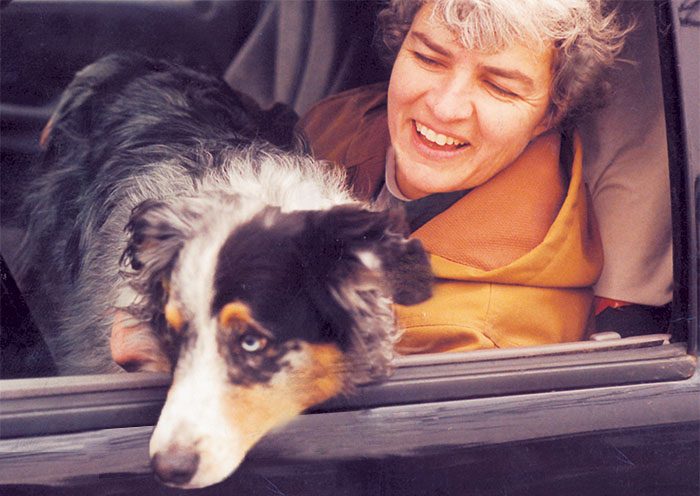
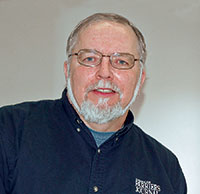






Post a comment
Report Abusive Comment